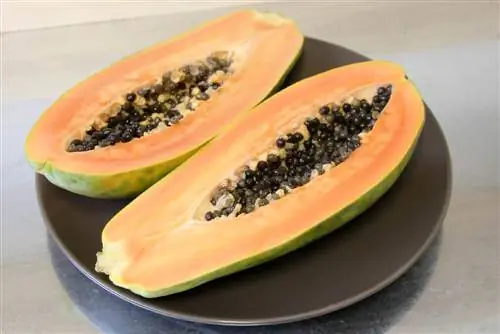- Author admin [email protected].
- Public 2023-12-17 03:39.
- Last modified 2025-01-24 12:45.
The real walnut tree has the botanical name Juglans regia and can grow to an impressive width and size. Fully grown specimens reach sizes between 15 and 25 meters, so that they clearly stand out in the tree population. If the site conditions are optimal, the trees can even grow several meters higher. However, the growth of the walnut tree can vary as it depends on many criteria.
Age-related factors
How big and quickly the walnut tree grows is determined by various factors. Certain influences promote or slow down the growth of the tree. This includes, above all, the age of the walnut. In addition, uneven growth is to be expected in the first few years of life, both in height and width. This circumstance is probably due to the tree's own supply and the still small trunk size. Once Juglans regia has developed properly, the tree can take care of itself better and grow more evenly. In this way, the required nutrients can also reach higher altitudes. After the sluggish initial period, growth can even increase by a few meters in the following years.
- Grows very irregularly in the first 3 years
- Growth is initially around 5-20 cm per year
- Then the growth increases to 20-45 cm per year
- Half-grown trees have stronger growth
- Height growth only becomes constant from the age of 10 onwards
- Then is between 50-100 cm per year
- Reaches its maximum possible height at around 80 years old
- Depending on the variety, it can reach a total height of 10-25 m
- In exceptional cases, specimens grow 30 m high
- Only a little height growth in the old age phase
- Walnut trees can live up to 160 years
Note:
As the walnut grows older, the crown neither grows wider nor does the overall height noticeably increase. In addition, yields decrease significantly during harvest.
Site conditions
The growth of the walnut tree depends heavily on the soil quality and nutrient supply. If these conditions are right, the tree grows significantly faster. Particularly in the middle phase of life, nutrient-rich soil greatly favors the development and growth of the walnut. If you buy Juglans regia from a specialist retailer, you have to take into account that the young tree will not develop as strongly in the first few years of life. So-called schooling is carried out on trees from the trade. As part of this measure, the young specimens are transplanted and the roots are cut back. This is intended to achieve a compact growth to make selling easier. These walnut trees generally need a few more years until they settle in and develop an average size growth.
- nutrient-rich loam and clay soils are ideal
- Calcareous soil also promotes growth
- Enrich nutrient-poor soils before planting
- Additional fertilizer if growth is weak
- The best option is to grow on site from the nut
- Then quickly forms a dense root system
- Avoid changing locations to avoid damaging roots
Tip:
Depending on the variety, the walnut tree begins to produce its delicious fruits between the 4th and 15th year.
Trunk circumference

An important influencing factor for the development of the walnut tree is the circumference of the trunk. The so-called vascular bundles, which supply the tree with water and important nutrients, run through the bark all the way to the last leaf. The more space there is for the vascular bundles in the bark, the better it is supplied. This circumstance affects and promotes both height and width growth. However, the walnut tree cannot grow endlessly and the trunk cannot become ever thicker. The reason for this is gravity on Earth, which is why the vascular bundles are no longer fully efficient at some point.
- Large trunk circumference promotes growth
- Girth only increases from the age of three onwards
- Trunk supplies tree through capillary effect
- Gravity increases with higher growth
- High gravity impairs capillary effect
- As a result, height growth begins to stagnate
Inventory density
When it comes to the walnut tree, there are other factors that can greatly influence growth. This includes, above all, the plant neighbors and the surrounding area. If Juglans regia grows around other trees, this is clearly reflected in its height growth. In addition, a location with optimal conditions can also be a hindrance to the growth of the walnut tree. Pruning can promote growth in many tree species, but the walnut does not belong to this group. In this way, Juglans regia has established itself as an extremely easy-care tree. If pruning measures are carried out, they do not hinder the development of the walnut. The tree then continues to grow just like it did last year.
- Walnut pushes upwards into the light when the population is dense
- Try to overtake neighboring trees
- Grows significantly higher in dense stands
- Growth becomes much faster there in the first few years
- However, this circumstance is only conducive to height growth
- The trunk neither gets thicker nor the harvest more productive
- Pruning also does not promote growth
- But needs topiary if tree grows too much






